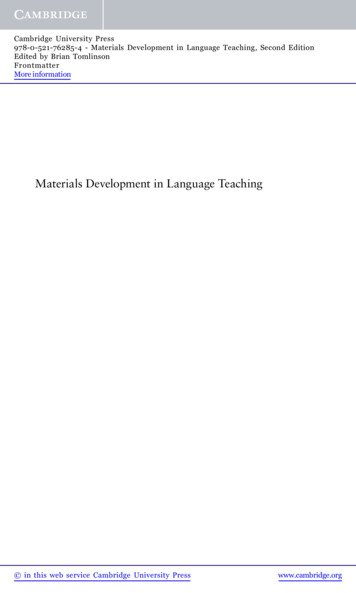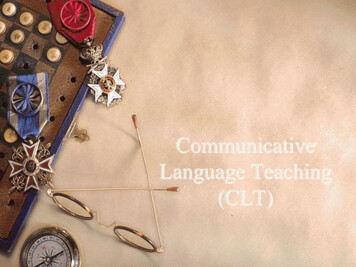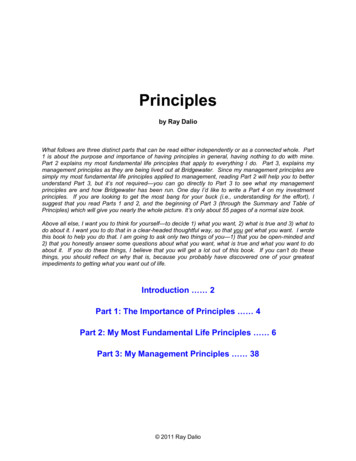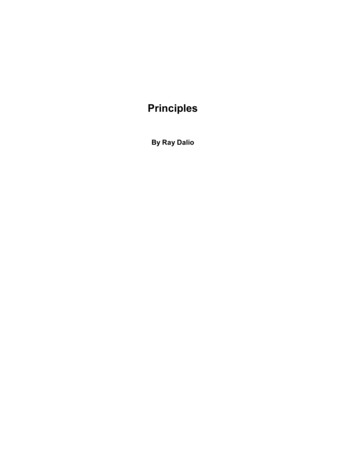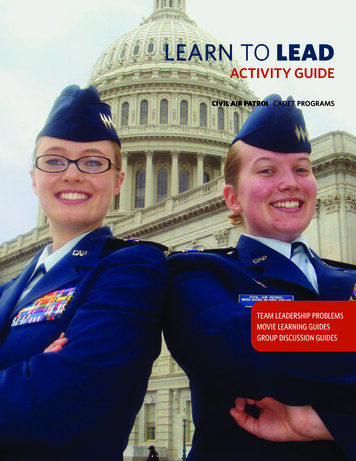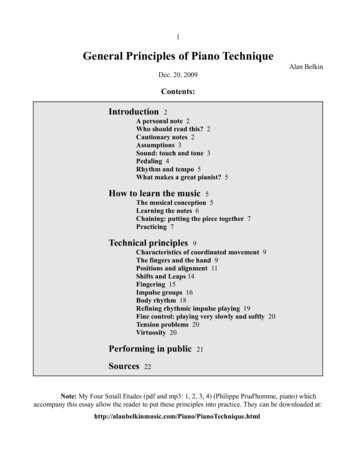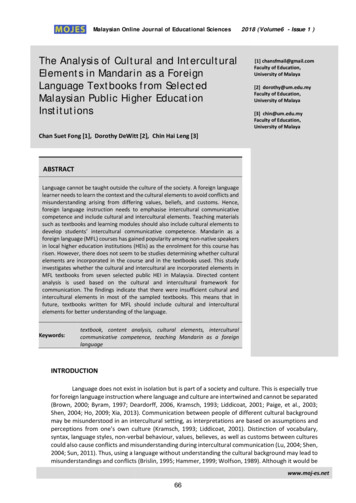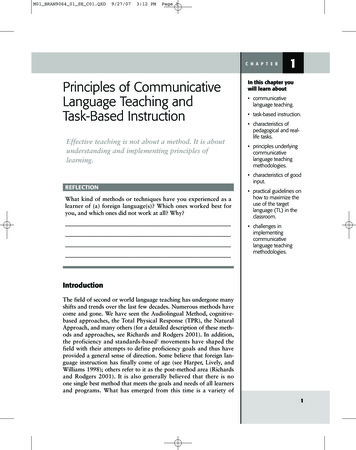
Transcription
M01 BRAN9064 01 SE C01.QXD9/27/073:12 PMPage 1C H A P T E RPrinciples of CommunicativeLanguage Teaching andTask-Based InstructionEffective teaching is not about a method. It is aboutunderstanding and implementing principles oflearning.1In this chapter youwill learn about communicativelanguage teaching. task-based instruction. characteristics ofpedagogical and reallife tasks. principles underlyingcommunicativelanguage teachingmethodologies. characteristics of goodinput.REFLECTIONWhat kind of methods or techniques have you experienced as alearner of (a) foreign language(s)? Which ones worked best foryou, and which ones did not work at all? Why? practical guidelines onhow to maximize theuse of the targetlanguage (TL) in theclassroom. challenges inimplementingcommunicativelanguage teachingmethodologies.IntroductionThe field of second or world language teaching has undergone manyshifts and trends over the last few decades. Numerous methods havecome and gone. We have seen the Audiolingual Method, cognitivebased approaches, the Total Physical Response (TPR), the NaturalApproach, and many others (for a detailed description of these methods and approaches, see Richards and Rodgers 2001). In addition,the proficiency and standards-based1 movements have shaped thefield with their attempts to define proficiency goals and thus haveprovided a general sense of direction. Some believe that foreign language instruction has finally come of age (see Harper, Lively, andWilliams 1998); others refer to it as the post-method area (Richardsand Rodgers 2001). It is also generally believed that there is noone single best method that meets the goals and needs of all learnersand programs. What has emerged from this time is a variety of1
M01 BRAN9064 01 SE C01.QXD29/27/073:12 PMPage 2CHAPTER ONEcommunicative language teaching (CLT) methodologies. Such methodologies encompass eclectic ways of teaching that are borrowed from myriad methods. Furthermore, they are rooted not only in one but a range oftheories and are motivated by research findings in second language acquisition (SLA) as well as cognitive and educational psychology. The purposeof this chapter is to provide an introduction to CLT and furthermoredescribe general methodological principles that function as theoreticaland practical guidelines when implementing CLT methodologies.The Shift Toward Communicative Language Teachingand Task-Based Instruction: A Historical PerspectiveFor many decades the predominant method of language instruction wasthe grammar-translation method. This method is rooted in the teachingof the nineteenth century and was widely used for the first half (in someparts of the world even longer) of the last century to teach modern foreign languages (Richards and Rodgers 2001). Textbooks primarily consisted of lists of vocabulary and rule explanations. By and large, studentsengaged in translation activities. Little oral proficiency would result fromthe Grammar-translation Method, and students often were expected togo abroad and immerse themselves to become a fluent speaker.The Grammar-translation Method was not without its opponents,and the demand for oral proficiency led to several counter and parallelmovements that laid the foundation for the development of new ways ofteaching, as we still know them today (Richards and Rodgers 2001).One such method is the Direct Method, sometimes also referred to as theBerlitz Method as it was widely used in Berlitz schools. Some reformersof the nineteenth century (e.g., Gouin and Sauveur) believed that languages should be taught in a natural way, that is, how children learn language. As Richards and Rodgers (2001) point out, “Believers in theNatural Method argued that a foreign language could be taught withouttranslation or the use of the learner’s native language if meaning wasconveyed directly through demonstration and action” (p. 11). For thisreason, they also strongly promoted the spontaneous use of language.Richards and Rodgers (2001, p. 12) describe principles of procedures underlying the Direct Method in the following way:1. Classroom instruction was conducted exclusively in the target language.2. Only everyday vocabulary and sentences were taught.3. Oral communication skills were built up in carefully graded progression organized around question-answer exchanges between teachersand students in small, intensive classes.4. Grammar was taught inductively.5. New teaching points were introduced orally.6. Concrete vocabulary was taught through demonstrating, objects,and pictures; abstract vocabulary was taught by association of ideas.
M01 BRAN9064 01 SE C01.QXD9/27/073:12 PMPage 3Principles of Communicative Language Teaching and Task-Based Instruction7. Both speech and listening comprehension were taught.8. Correct pronunciation and grammar were emphasized.Despite its success in private schools, the Direct Method was metwith a great deal of criticism. Strict requirements to adhere to its principles and the need for native speakers or someone with native-like fluencyprevented this method from becoming widely adopted by academic institutions (see Richards and Rodgers 2001).Hailed in its day as revolutionary in foreign language teaching, thegrammar-translation method was replaced by the Audiolingual Method inthe 1950s and 60s. The belief in the effectiveness of this method was sostrong that traces of audiolingual-based teaching theories can still be foundin teaching materials. The audiolingual method was based on the school ofbehaviorism in psychology and structuralism in linguistics, for which reason it also become known as the “structural” or “behaviorist” method.Because of its primary emphasis on spoken language, it is also referred toas the “Aural-oral” Method. The underlying assumption of this philosophy was that, as Rivers (1964) put it, foreign language learning is basicallya mechanical process of habit formation and automatization. In practice,this meant students were presented with language patterns and dialogues,which they had to mimic and memorize. Language practice by and largeconsisted of repetition of language patterns and drill exercises. Drill typesincluded substitution drills, variation drills, translation drills, and responsedrills. The following Swedish example illustrates a combination of a substitution and translation drill.ILLUSTRATION 1Substitution/transformation drillHan har alltid HUNDEN med sig. [He always has his dog with him].the map—the fountain pen—the ink—the paper—the carThe teacher says, “Han har alltid hunden med sig.” [He always has hisdog with him].Student chooses from a given list of English words, translates it intoSwedish, and substitutes the underlined word of the example sentence.A tenet of this method was that errors of any kind were to beavoided, so the learners were not to establish bad habits. For this reason,the native speaker teacher was considered the perfect model.There were, however, many problems with audiolingual approaches.The teacher, who was often seen like the drillmaster, carried the responsibility of teaching and student learning like an atlas on his shoulder(Lee and VanPatten 2003). One of the most widely brought forwardpoints of criticism toward this method is that the learners lacked engagement in meaningful language use and had only limited opportunities to3
M01 BRAN9064 01 SE C01.QXD49/27/073:12 PMPage 4CHAPTER ONEuse language creatively while interacting with their peers. As Willis(2004) points out, “This was because the emphasis was on eradication oferrors and accurate production of the target forms, not on communication of meanings” (p. 4). Due to overcorrection of students’ errors by theteacher, anxiety levels were often quite high among students. TheAudiolingual Method failed to have the desired effect of helping learnersbecome competent speakers in the TL.Several factors and influences led to the demise of the AudiolingualMethod and caused a shift in language teaching methodology. Thisbrought forth communicative language approaches and a range of alternative methods.1. The Audiolingual Method did not live up to its promise creatingspeakers who were able to communicate in the target language.2. Theories of learning moved away from behaviorist views of learning.The most influential work was the one by Chomsky, which was published in his book Syntactic Structures (1957). He argued that language learning involves creative processes and perceived language asrule-governed creativity. As Willis (2004) describes it, “He believedthat a basic rule system that underpins all languages is innate andthat, given exposure to a specific language, children will naturallycreate the specific rules of that language for themselves. Learning isthus seen as a process of discovery determined by internal processesrather than external influences” (pp. 4–5).3. Works by scholars and sociolinguists such as J. Firth, M. Halliday,D. Hymes, and J. Austin led to a change in the way language wasviewed. As emphasized by many practitioners, the primary purposeof language is to communicate.4. The development of a functional-notional syllabus in the 1970s inEurope by Van Ek (1973) and Wilkins (1976) initiated a new way ofhow teaching materials were organized. Traditionally, syllabi hadbeen organized around grammatical structures and vocabulary units.The functional-notional syllabus attempted to show what learnersneed to do with language and what meanings they need to communicate, and organized the syllabus around functions and notions.Functions are communicative speech acts such as “asking,”“requesting,” “denying,” “arguing,” “describing,” or “requesting.”Notional categories include concepts such as “time” or “location.”Notions and functions are different from topics and situations asthey express more precise categories. For example, a topic may be“family,” the situation “coming for a visit and having dinner.” Thefunction and the notion that is addressed in this unit may involve“inviting” and “time past” (e.g., past tenses, expressions like “lastweek,” “a few days ago”). The functional-notional syllabus laid thegroundwork that ultimately led textbook writers to organize theirmaterials in terms of communicative situations, and some also invery concrete communicative tasks.
M01 BRAN9064 01 SE C01.QXD9/27/073:12 PMPage 5Principles of Communicative Language Teaching and Task-Based Instruction5. A growing number of research studies in applied linguistics haveprovided many new insights and a deeper understanding of secondlanguage learning and SLA processes. Some of these include Learners move through different stages of development (Selinker1972). Learners develop an underlying language system that develops in asequence that does not always reflect the sequence of what wastaught in a curriculum (Dulay and Burt 1973). Work by Pienemann(1989) showed that learners develop language skills according totheir own internal syllabus.Alternative approaches and methods to language teachingWhile communicative language teaching methodologies kept evolving andbeing more clearly defined, in the 1970s and 80s a set of alternativeapproaches and methods emerged. Some of these include comprehensionbased methods such as the Total Physical Response (TPR), the NaturalApproach, the Silent Way, or Suggestopedia (for a detailed description ofthese methods, see Richards and Rodgers 2001). Many of these methodsnever became widely adapted and had only a short shelf life. This is not tosay that these methods did not contribute to the field of language teaching.On the contrary, some of these methods have helped shape and continue tohave an influence on the field in many ways. For example, TPR, whichJames Asher (1969) originally developed as a method to teach language bycombining action and speech, is still widely used. Many practitioners,however, promote and use TPR as a technique to introduce some vocabulary or grammatical structures. Some principles of learning that have beenpromoted through these methods are integrated in the discussion below.What Is Communicative Language Teaching?Communicative language teaching (CLT) is generally regarded as anapproach to language teaching (Richards and Rodgers 2001). As such,CLT reflects a certain model or research paradigm, or a theory (CelceMurcia 2001). It is based on the theory that the primary function of language use is communication. Its primary goal is for learners to developcommunicative competence (Hymes 1971), or simply put, communicative ability. In other words, its goal is to make use of real-life situationsthat necessitate communication.Defining communicative competenceCommunicative competence is defined as the ability to interpret andenact appropriate social behaviors, and it requires the active involvementof the learner in the production of the target language (Canale and Swain5
M01 BRAN9064 01 SE C01.QXD69/27/073:12 PMPage 6CHAPTER ONE1980; Celce-Murcia et al. 1995; Hymes 1972). Such a notion encompasses a wide range of abilities: the knowledge of grammar and vocabulary (linguistic competence); the ability to say the appropriate thing in acertain social situation (sociolinguistic competence); the ability to start,enter, contribute to, and end a conversation, and the ability to do this ina consistent and coherent manner (discourse competence); the ability tocommunicate effectively and repair problems caused by communicationbreakdowns (strategic competence).As frequently misunderstood, CLT is not a method per se. That is tosay, it is not a method in the sense by which content, a syllabus, andteaching routines are clearly identified (see Richards and Rodgers 2001).CLT has left its doors wide open for a great variety of methods and techniques. There is no single text or authority on it, nor any single modelthat is universally accepted as authoritative (Richards and Rodgers2001). By and large, it uses materials and utilizes methods that areappropriate to a given context of learning.CLT has spawned various movements such as proficiency-based orstandard-based instruction. While the early days of CLT were concernedwith finding best designs and practices, the proficiency-based movementcontributed to the field of language teaching by putting forward a set ofproficiency guidelines (see American Council on the Teaching of ForeignLanguages [ACTFL] guidelines in Chapter 8, Developing OralCommunication Skills). These guidelines describe language ability andare meant to be used to measure competence in a language (OmaggioHadley 2001). In this sense, the proficiency-based movement focusedon measuring what learners can do in functional terms. By providingevaluative descriptions, that is, by specifying what students shouldknow and how they should be able to use language within a variety ofcontexts and to various degrees of accuracy at different stages, it provided a set of broadly stated goals and thus a sense of direction forcurriculum designers. The standard-based movement attempted to further streamline descriptions of what students should know and be able todo after completing a particular grade level or curriculum to meetnational standards in foreign language education from kindergarten touniversity. In this way, both movements positively influenced andstrengthened the development and implementation of communicativeoriented teaching practices.As far as theories of learning and effective strategies in teaching areconcerned, CLT does not adhere to one particular theory or method. Itdraws its theories about learning and teaching from a wide range ofareas such as cognitive science, educational psychology, and second language acquisition (SLA). In this way, it embraces and reconciles manydifferent approaches and points of view about language learning andteaching, which allows it to meet a wide range of proficiency-orientedgoals and also accommodate different learner needs and preferences.Despite the lack of universally accepted models, from early on, there has
M01 BRAN9064 01 SE C01.QXD9/27/073:12 PMPage 7Principles of Communicative Language Teaching and Task-Based Instructionbeen some degree of consensus regarding the qualities required to justifythe label “CLT,” which Wesche and Skehan (2002) describe as: Activities that require frequent interaction among learners or withother interlocutors to exchange information and solve problems. Use of authentic (non-pedagogic) texts and communication activitieslinked to “real-world” contexts, often emphasizing links across written and spoken modes and channels. Approaches that are learner centered in that they take into accountlearners’ backgrounds, language needs, and goals and generally allowlearners some creativity and role in instructional decisions (p. 208).With no one particular method or theory that underlies their practical and theoretical foundation, CLT methodologies are best described asa set of macro-strategies (Kumaradivelu 1994) or methodological principles (Doughty and Long 2003). The following section describes suchprinciples in more detail.Methodological Principles of Communicative LanguageTeaching and Task-Based InstructionDoughty and Long (2003) define methodological principles as a list ofdesign features that can be generally regarded as being facilitative to second language acquisition. The following list, adapted from Doughty andLong (2003), serves as a guideline for implementing communicative language teaching (CLT) practices.Principle 1: Use Tasks as an Organizational PrincipleFor decades traditional methods of language teaching have used grammartopics or texts (e.g., dialogues, short stories) as a basis for organizing asyllabus. With CLT methodologies this approach has changed; the development of communicative skills is placed at the forefront, while grammaris now introduced only as much as needed to support the development ofthese skills. This raises questions on how to organize a syllabus. Someproponents (see Breen 1987; Long 1985; Nunan 1989; Prabhu 1987) suggest using tasks as central units that form the basis of daily and long-termlesson plans. Such an approach to syllabus design has become known astask-based instruction (TBI). The rationale for the employment of communicative tasks is based on contemporary theories of language learningand acquisition, which claim that language use is the driving force for language development (Long 1989; Prabhu 1987). For example, advocatesof such theories (see Pica, Kanagy, and Falodun 1993) suggest that, asNorris et al. (1998) put it, “the best way to learn and teach a language is7
M01 BRAN9064 01 SE C01.QXD89/27/073:12 PMPage 8CHAPTER ONEthrough social interactions. [. . . they] allow students to work toward aclear goal, share information and opinions, negotiate meaning, get theinterlocutor’s help in comprehending input, and receive feedback on theirlanguage production. In the process, learners not only use their interlanguage, but also modify it, which in turn promotes acquisition” (p. 31). Inother words, it is not the text one reads or the grammar one studies butthe tasks that are presented that provide learners a purpose to use thegrammar in a meaningful context. This gives task design and its use a pivotal role in shaping the language learning process.What are tasks? Numerous competing definitions of tasks exist. Manyof these definitions focus on different aspects of what constitutes a task.Below you will find three different interpretations of the word task, eachof which highlights different nuances of the term.One of the most widely quoted definitions for task is offered byLong (1985). He refers to a task asa piece of work undertaken for oneself or for others, freely or for somereward. Thus examples of tasks include [. . .] filling out a form, buying apair of shoes, making an airline reservation, borrowing a library book,taking a driving test, typing a letter, [. . .], making a hotel reservation,writing a check, finding a street destination and helping someone acrossthe road. In other words, by “task” is meant the hundred and one thingspeople do in everyday life, at work, at play, and in between (p. 89).Another well-known definition is provided by Nunan (1989). Heconsiders a task asany classroom work which involves learners in comprehending, manipulating, producing, or interacting in the target language while theirattention is principally focused on meaning rather than form ( p. 10).More recently, Skehan (1998) summarizes the parameters for a taskactivity in the following way:“(a) meaning is primary, (b) learners are not given other people’s meanings to regurgitate, (c) there is some sort of relationship to comparablereal-world activities, (d) task completion has a priority, and (e), theassessment of tasks are done in terms of outcome” (p. 147).From these definitions, despite the various interpretations, severalcommon design features can be identified. These features include: Allthree definitions emphasize the importance of focus on meaning. Thiscriterion supports the notion that conveying an intended meaning is theessence of language use (see Principle 4 for further discussion). Long(1985) and Skehan’s (1998) definitions emphasize the use of real-worldtasks or activities that are comparable to authentic task behavior.Performing real-world tasks also necessitates the use of real language to
M01 BRAN9064 01 SE C01.QXD9/27/073:12 PMPage 9Principles of Communicative Language Teaching and Task-Based Instructionaccomplish these tasks. Skehan (1998) further suggests that task performance often involves achieving a goal or an objective, or arriving atan outcome or an end product. Meanwhile, Nunan’s (1989) definitionmakes specific reference to the classroom environment and points outthat task performance may entail employing a single skill or a combination of several skills. His description recognizes the pedagogical needs forfocusing on skills in isolation in language learning.One of the challenges of task-based learning and instruction is thatengaging students in a variety of tasks is necessary to promote acquisition.Students have many pedagogical needs which often necessitate a differentapproach to teaching. For example, learners need to engage in psycholinguistic and metalinguistic processes such as repeating, noticing forms,hypothesizing and conceptualizing rules, which have been found byresearch as being conducive to the language acquisition process. For thisreason, Nunan (1993) distinguishes between two kinds of tasks: Real-worldtasks and pedagogical tasks. Real-world tasks are designed to emphasizethose skills that learners need to have so they can function in the real world.Such tasks normally simulate authentic task behavior, and their primaryfocus is often the achievement of an end product. For such reasons, thesekinds of tasks normally make up the final goal of a lesson or a unit.In contrast to real-life tasks, pedagogical tasks are intended to act asa bridge between the classroom and the real world in that they serve toprepare students for real-life language usage (see Long, 1998). Such tasksare often referred to as “preparation” or “assimilation” tasks. They aredesigned to promote the language acquisition process by taking intoaccount a teacher’s pedagogical goal, the learner’s developmental stageand skill level, and the social contexts of the second-language learningenvironment. They often have an enabling character, i.e., they aid thelearners in their understanding of how language works and also in thedevelopment of learning skills and strategies in general. In addition, theyfocus on skills in isolation and within a narrow context. Pedagogical tasksdo not necessarily reflect real-world tasks. For instance, the preparationtask in Appendix 3 illustrates such an example. In this assimilation task,students complete descriptions with words that are missing. The rationalefor this design is that students first need to learn some basic facts.Furthermore, their attention is directed to particular vocabulary and verbforms in isolation, which they need to apply in the subsequent task.Sample task-based lessons. Illustrations 2 and 3 describe two differenttask-based lessons. The goal of the Lesson on organizing a welcome dinner (Illustration 2) is for learners to arrange a group of international students at dinner tables based on factors such as what the students’ hobbiesare, what languages they speak, or their age. The final goal of the lessonexample in Illustration 3 is for students to set up and collect informationfor an address book. They are to find out the following information fromthree of their classmates: first name, last name, phone number or e-mailaddress, and why they are learning French. While both lesson models are9
M01 BRAN9064 01 SE C01.QXD109/27/073:12 PMPage 10CHAPTER ONEorganized by aiming at the achievement of a final task, they can be distinguished by what here is referred to as a “strong” or “dependent task”design. In the lesson on organizing a welcome dinner, which follows a“dependent” task design, all sub-steps are connected and situated within acontextualized framework. Students have to do something with the information they gather and also have to use this information in subsequenttasks, which lead up to a final task. The completion of all tasks involvesmultiple and different kinds of speech acts. For learners to achieve thefinal lesson goal, the successful completion of all tasks preceding the finaltasks is required. Ultimately, performing the final target task is driven bygathering information in a communicative way during each subtask.Illustration 3 follows a “task independent” design. The purpose ofeach task that leads up to the final task is to engage the learner in thedevelopment of skills that are needed to perform the final lesson task.While each task is contextualized and engages the learner in real-lifespeech application, they are not necessarily connected by one commontheme. While communicative language use is still practiced during eachtask, the need for exchanging and gathering information in a communicative way to achieve the final lesson goal, however, is not the driving force.ILLUSTRATION 2Organizing a welcome dinner (see Appendix 3 for the entirelesson)Step 1. Students organize the group of international students aroundthree dinner tables. For example, a student might say: “On table1, Andrew Smith and Sandra Mogambe sit next to each other,because they both speak Spanish and collect butterflies.”Step 2. Students listen to new information about the students given tothem by their Spanish teachers and if necessary rearrange students at the tables.Step 3. Students provide some personal information about themselves.Then they choose a student from their own group, who also wantsto attend the welcome dinner, and select a table for this student.Step 4. Now you are going to revise your distribution and write a briefreport.Step 5. A representative from each group presents their report and justifies the group decision.Step 6. The groups and the teacher compare the results.ILLUSTRATION 3Setting up an address bookStep 1. You are in a language school and the instructor is taking attendance. Students read the names of students and check who ispresent.
M01 BRAN9064 01 SE C01.QXD9/27/073:12 PMPage 11Principles of Communicative Language Teaching and Task-Based InstructionStep 2. Students listen to their teacher pronounce French names andshare with the class French names that they are familiar with.Step 3. A.B.Students match (associate) numbers with twelve photosthat represent cultural themes. The photos are marked withsome letters from the alphabet.Students count from 1-12.Step 4. Students listen to the result of a song contest broadcasted onTV. They complete a chart and write down the points that eachcountry was awarded.Step 5. A.B.Students are asked to write down the names of sevenEuropean countries. (The article and the first letter of eachcountry name are provided.) The teacher follows up withthe question: How do you spell L’Allemagne?Students locate the names of European countries on the map.Step 6. Students express their opinions about where they believe a set ofphotos was taken. Students work in pairs. For example, onestudent would ask in French: La photo numéro deux,c’est la France? [Photo number 2, is this France?] Her partnermight respond, Non, ce n’est pas la France, je crois que c’est laGrande-Bretagne. [No, it is not France, I believe it is Great Britain.]Step 7. Students listen to a recording of first and last names, and compare the spelling. They look for letters that are pronounced thesame way, and those that are pronounced differently.Step 8. Students match names of famous French celebrities with a corresponding photo and caption. Students express who theybelieve these people are. For example, a student might say:La photo numéro 1, c’est Marguerite Duras? [Photo number 1,is this Marguerite Duras?] Her partner might respond, Non,ce n’est pas Marguerite Duras, je crois que c’est IsabelleAdjani. [No, it is not Marguerite Duras, I believe it isIsabelle Adjani.]Step 9. A.Students listen to three different dialogues in which peopleexplain why they are learning French. They have to numberthe sentences (reasons) to identify who says what.B.Students share their reason for why they are studying French.As seen from the examples above, task-based instruction as a modelof syllabus design has an emphasis on performance. Achievement is measured based on whether or to what extent learners can successfully perform the pedagogic and real-life tasks. However, it needs to be pointedout that using tasks as organizational units of daily and long-term plans isnot without challenges. These challenges have to do with task choice, taskdifficulty and sequencing. Furthermore, depending on the complexity oftarget language structures, task designs often require careful adaptationsas to what linguistic structures learners can a
Method and caused a shift in language teaching methodology. This brought forth communicative language approaches and a range of alter-native methods. 1. The Audiolingual Method did not live up to its promise creating speakers who were able to communicate in the target language. 2. Theories o

